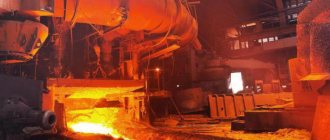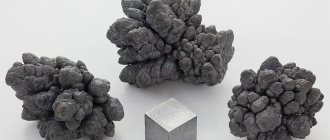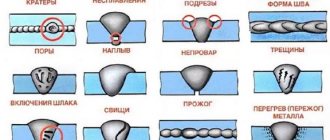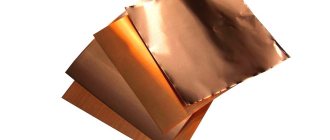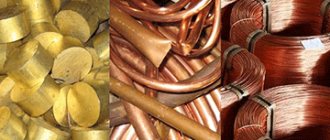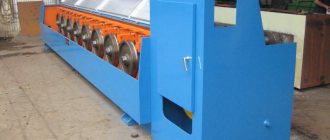Thermal conductivity of non-ferrous metals and technical alloys
The table shows the thermal conductivity values of metals (non-ferrous), as well as the chemical composition of metals and technical alloys in the temperature range from 0 to 600°C.
Non-ferrous metals and alloys: nickel Ni, monel, nichrome; nickel alloys (according to GOST 492-58): cupronickel NM81, NM70, constantan NMMts 58.5-1.54, copel NM 56.5, monel NMZhMts and K-monel, alumel, chromel, manganin NMMts 85-12, invar; magnesium alloys (according to GOST 2856-68), electron, platinum-rhodium; soft solders (according to GOST 1499-70): pure tin, lead, POS-90, POS-40, POS-30, Rose alloy, Wood alloy.
The table shows that magnesium alloys and nickel have high thermal conductivity (at room temperature). Low thermal conductivity is characteristic of nichrome, invar and Wood's alloy.
What does thermal conductivity depend on?
Studying the ability of heat transfer by metal products, it was revealed that thermal conductivity depends on:
- type of metal;
- chemical composition;
- porosity;
- sizes.
Metals have different crystal lattice structures, and this can change the thermal conductivity of the material. For example, in steel and aluminum, the structural features of microparticles affect differently the rate of transfer of thermal energy through them.
The thermal conductivity coefficient can have different values for the same metal when the exposure temperature changes. This is due to the fact that different metals have different melting degrees, which means that under other environmental parameters, the properties of the materials will also differ, and this will affect thermal conductivity.
Thermal conductivity coefficients of aluminum, copper and nickel alloys
The thermal conductivity of metals, aluminum, copper and nickel alloys in the table is given in the temperature range from 0 to 600°C in the dimension W/(m deg). Metals and alloys: aluminum, aluminum alloys, duralumin, brass, copper, monel, nickel silver, nichrome, ferrous nichrome, mild steel. Aluminum alloys have greater thermal conductivity than brass and nickel alloys.
Fourier's law of thermal conductivity
In steady state, the energy flux density transmitted through thermal conductivity is proportional to the temperature gradient:
where q→ >> is the heat flux density vector - the amount of energy passing per unit time through a unit area perpendicular to each axis, ϰ is the thermal conductivity coefficient
(specific thermal conductivity), T - temperature.
The minus on the right side shows that the heat flow is directed opposite to the vector grad(T) (T)> (that is, in the direction of the fastest decrease in temperature). This expression is known as Fourier's
law of heat conduction .
In integral form, the same expression will be written as follows (if we are talking about a stationary heat flow from one side of the parallelepiped to the other):
where P is the total heat loss power, S is the cross-sectional area of the parallelepiped, ΔT is the temperature difference between the faces, l is the length of the parallelepiped, that is, the distance between the faces.
Connection with electrical conductivity
The connection between the thermal conductivity coefficient ϰ and the electrical conductivity σ in metals is established by the Wiedemann-Franz law:
Thermal conductivity coefficient of gases
In gases, the thermal conductivity coefficient can be found using the approximate formula
where ρ is the gas density, cv > is the specific heat capacity at constant volume, λ is the average free path of gas molecules, v¯ >> is the average thermal velocity. The same formula can be written as
where i is the sum of the translational and rotational degrees of freedom of molecules (for a diatomic gas i=5, for a monatomic gas i=3), k is Boltzmann’s constant, μ is the molar mass, T is the absolute temperature, d is the effective (gas-kinetic) diameter of the molecules, R — universal gas constant. From the formula it is clear that heavy monatomic (inert) gases have the lowest thermal conductivity, and light polyatomic gases have the highest (which is confirmed by practice, the maximum thermal conductivity of all gases is hydrogen, the minimum is radon, and of non-radioactive gases is xenon).
Thermal conductivity in highly rarefied gases
The above expression for the coefficient of thermal conductivity in gases does not depend on pressure. However, if the gas is very rarefied, then the mean free path is determined not by the collisions of molecules with each other, but by their collisions with the walls of the container. The state of a gas in which the free path of molecules is limited by the dimensions of the vessel is called high vacuum.
. At high vacuum, thermal conductivity decreases in proportion to the density of the substance (that is, proportional to the pressure in the system): ϰ∼13ρcvlv¯∝P >rho c_ l >propto P>, where l is the size of the vessel, P is the pressure.
Thus, the thermal conductivity coefficient of vacuum is closer to zero, the deeper the vacuum. This is due to the low concentration in vacuum of material particles capable of transferring heat. However, energy in a vacuum is transferred through radiation. Therefore, for example, to reduce heat loss, the walls of a thermos are made double, silvered (such a surface reflects radiation better), and the air between them is pumped out.
Thermal conductivity coefficients of alloys
The table shows the thermal conductivity values of alloys in the temperature range from 20 to 200ºС. Alloys: aluminum bronze, bronze, phosphor bronze, invar, constantan, manganin, magnesium alloys, copper alloys, Rose alloy, Wood's alloy, nickel alloys, nickel silver, platinum-iridium, electron alloy, platinum-rhodium.
Thermal conductivity of copper - how does it affect the properties of copper?
In physics, thermal conductivity is understood as the movement of energy in an object from more heated small particles to less heated ones. Thanks to this process, the temperature of the object in question as a whole is equalized.
The magnitude of the ability to conduct heat is characterized by the thermal conductivity coefficient.
This parameter is equal to the amount of heat that a material 1 meter thick passes through a surface area of 1 m2 for one second at a unit temperature difference.
Copper has a thermal conductivity coefficient of 394 W/(m*K) at temperatures from 20 to 100 °C. Only silver can compete with it. And for steel and iron this figure is 9 and 6 times lower, respectively (see table).
It is worth noting that the thermal conductivity of products made from copper largely depends on impurities (however, this also applies to other metals).
For example, the rate of heat conduction decreases if substances such as:
If you add zinc to copper, you get brass, which has a much lower thermal conductivity coefficient. At the same time, adding other substances to copper can significantly reduce the cost of finished products and give them characteristics such as strength and wear resistance. For example, brass is characterized by higher technological, mechanical and anti-friction properties.
Since high thermal conductivity is characterized by rapid distribution of heating energy throughout the entire object, copper is widely used in heat exchange systems. At the moment, radiators and tubes for refrigerators, vacuum units and cars are made from it for rapid heat removal. Copper elements are also used in heating installations, but for heating.
Copper heating radiator
In order to maintain the thermal conductivity of the metal at a high level (and therefore make the operation of copper devices as efficient as possible), forced airflow by fans is used in all heat exchange systems. This decision is due to the fact that as the temperature of the environment increases, the thermal conductivity of any material decreases significantly, because heat transfer slows down.
The concept of thermal resistance and thermal conductivity coefficient
If thermal conductivity characterizes the ability of metals to transfer the temperature of bodies from one surface to another, then thermal resistance shows an inverse relationship, i.e. the ability of metals to prevent such transfer, in other words, to resist. Air has high thermal resistance. It is he who, most of all, prevents the transfer of heat between bodies.
The quantitative characteristic of the change in temperature of a unit area per unit of time by one degree (K) is called the thermal conductivity coefficient. The international system of units usually measures this parameter in W/m*deg. This characteristic is very important when choosing metal products that must transfer heat from one body to another.
| Metal | Thermal conductivity coefficient of metals at temperature, °C | ||||
| — 100 | 100 | 300 | 700 | ||
| Aluminum | 2,45 | 2,38 | 2,30 | 2,26 | 0,9 |
| Beryllium | 4,1 | 2,3 | 1,7 | 1,25 | 0,9 |
| Vanadium | — | — | 0,31 | 0,34 | — |
| Bismuth | 0,11 | 0,08 | 0,07 | 0,11 | 0,15 |
| Tungsten | 2,05 | 1,90 | 1,65 | 1,45 | 1,2 |
| Hafnium | — | — | 0,22 | 0,21 | — |
| Iron | 0,94 | 0,76 | 0,69 | 0,55 | 0,34 |
| Gold | 3,3 | 3,1 | 3,1 | — | — |
| Indium | — | 0,25 | — | — | — |
| Iridium | 1,51 | 1,48 | 1,43 | — | — |
| Cadmium | 0,96 | 0,92 | 0,90 | 0,95 | 0,44 (400°) |
| Potassium | — | 0,99 | — | 0,42 | 0,34 |
| Calcium | — | 0,98 | — | — | — |
| Cobalt | — | 0,69 | — | — | — |
| Lithium | — | 0,71 | 0,73 | — | — |
| Magnesium | 1,6 | 1,5 | 1,5 | 1,45 | — |
| Copper | 4,05 | 3,85 | 3,82 | 3,76 | 3,50 |
| Molybdenum | 1,4 | 1,43 | — | — | 1,04 (1000°) |
| Sodium | 1,35 | 1,35 | 0,85 | 0,76 | 0,60 |
| Nickel | 0,97 | 0,91 | 0,83 | 0,64 | 0,66 |
| Niobium | 0,49 | 0,49 | 0,51 | 0,56 | — |
| Tin | 0,74 | 0,64 | 0,60 | 0,33 | — |
| Palladium | 0,69 | 0,67 | 0,74 | — | — |
| Platinum | 0,68 | 0,69 | 0,72 | 0,76 | 0,84 |
| Rhenium | — | 0,71 | — | — | — |
| Rhodium | 1,54 | 1,52 | 1,47 | — | — |
| Mercury | 0,33 | 0,09 | 0.1 | 0,115 | — |
| Lead | 0,37 | 0,35 | 0,335 | 0,315 | 0,19 |
| Silver | 4,22 | 4,18 | 4,17 | 3,62 | — |
| Antimony | 0,23 | 0,18 | 0,17 | 0,17 | 0,21 |
| Thallium | 0,41 | 0,43 | 0,49 | 0,25 (400 0) | |
| Tantalum | 0,54 | 0,54 | — | — | — |
| Titanium | — | — | 0,16 | 0,15 | — |
| Thorium | — | 0,41 | 0,39 | 0,40 | 0,45 |
| Uranus | — | 0,24 | 0,26 | 0,31 | 0,40 |
| Chromium | — | 0,86 | 0,85 | 0,80 | 0,63 |
| Zinc | 1,14 | 1,13 | 1,09 | 1,00 | 0,56 |
| Zirconium | — | 0,21 | 0,20 | 0,19 | — |
: Steel nitriding: process technology, equipment
Aluminum and copper - which is better?
Aluminum has one disadvantage compared to copper: its thermal conductivity is 1.5 times less, namely 201–235 W/(m*K). However, compared to other metals, these are quite high values. Aluminum, like copper, has high anti-corrosion properties. In addition, it has advantages such as:
- low density (specific gravity 3 times less than that of copper);
- low cost (3.5 times less than copper).
Aluminum heating radiator
Thanks to simple calculations, it turns out that an aluminum part can be almost 10 times cheaper than a copper part, because it weighs much less and is made of cheaper material.
This fact, along with high thermal conductivity, allows the use of aluminum as a material for cookware and food foil for ovens.
The main disadvantage of aluminum is that it is softer, so it can only be used in alloys (for example, duralumin).
For effective heat transfer, the rate of heat transfer to the environment plays an important role, and this is actively facilitated by the cooling of radiators. As a result, the lower thermal conductivity of aluminum (relative to copper) is leveled out, and the weight and cost of the equipment are reduced. These important advantages allow aluminum to gradually replace copper from use in air conditioning systems.
Use of copper in electronics
In some industries, for example, in the radio industry and electronics, copper is essential.
The fact is that this metal is very ductile in nature: it can be drawn into extremely thin wires (0.005 mm), and also can be used to create other specific conductive elements for electronic devices.
And high thermal conductivity allows copper to extremely effectively remove the heat that inevitably arises during the operation of electrical appliances, which is very important for modern high-precision, but at the same time compact equipment.
The use of copper is relevant in cases where it is necessary to deposit a certain shape on a steel part. In this case, a copper template is used, which is not connected to the element being welded. Using aluminum for these purposes is impossible, as it will melt or burn through. It is also worth mentioning that copper can act as a cathode when welding with a carbon arc.
What is thermal conductivity and why is it needed?
The process of transferring the energy of atoms and molecules from hot objects to products with a cold temperature is carried out during the chaotic movement of moving particles. Such heat exchange depends on the state of aggregation of the metal through which the transmission passes.
Depending on the chemical composition of the material, thermal conductivity will have different characteristics.
This process is called thermal conductivity, it consists in the transfer of kinetic energy by atoms and molecules, which determines the heating of a metal product during the interaction of these particles, or is transferred from a warmer part to one that is less heated.
The ability to transfer or store thermal energy makes it possible to use the properties of metals to achieve the necessary technical goals in the operation of various components and assemblies of equipment used in the national economy.
An example of such an application would be a soldering iron that heats up in the middle part and transfers heat to the edge of the working rod, which is used to solder the necessary elements.
Knowing the properties of thermal conductivity, metals are used in all industries, using the required parameter for its intended purpose.
What does thermal conductivity depend on?
Studying the ability of heat transfer by metal products, it was revealed that thermal conductivity depends on:
- type of metal;
- chemical composition;
- porosity;
- sizes.
Metals have different crystal lattice structures, and this can change the thermal conductivity of the material. For example, in steel and aluminum, the structural features of microparticles affect differently the rate of transfer of thermal energy through them.
The thermal conductivity coefficient can have different values for the same metal when the exposure temperature changes. This is due to the fact that different metals have different melting degrees, which means that under other environmental parameters, the properties of the materials will also differ, and this will affect thermal conductivity.
Measurement methods
To measure the thermal conductivity of metals, two methods are used: stationary and non-stationary. The first is characterized by the achievement of a constant value of the changed temperature on the controlled surface, and the second - by a partial change in it.
Stationary measurement is carried out experimentally, requires a lot of time, as well as the use of the metal under study in the form of blanks of the correct shape, with flat surfaces.
The sample is placed between the heated and cooled surface, and after touching the planes, the time during which the workpiece can increase the temperature of the cool support by one degree Kelvin is measured.
When calculating thermal conductivity, the dimensions of the sample being studied must be taken into account.
Non-stationary research methods are used in rare cases due to the fact that the result is often biased. Nowadays, no one except scientists is involved in measuring the coefficient; everyone uses long-established experimental values for various materials. This is due to the constancy of this parameter while maintaining the chemical composition of the product.
Thermal conductivity of steel, copper, aluminum, nickel and their alloys
Ordinary iron and non-ferrous metals have different structures of molecules and atoms. This allows them to differ from each other not only in mechanical properties, but also in thermal conductivity properties, which, in turn, affects the use of certain metals in various sectors of the economy.
table 2
Steel has a thermal conductivity coefficient at an ambient temperature of 0 degrees. (C) equal to 63, and when the degree increases to 600, it decreases to 21 W/m*degree.
Aluminum, under the same conditions, on the contrary, will increase the value from 202 to 422 W/m*deg. Aluminum alloys will also increase thermal conductivity as the temperature increases.
Only the value of the coefficient will be an order of magnitude lower, depending on the amount of impurities, and range from 100 to 180 units.
Copper, with a temperature change within the same limits, will reduce thermal conductivity from 393 to 354 W/m*deg. At the same time, copper-containing brass alloys will have the same properties as aluminum ones, and the thermal conductivity value will vary from 100 to 200 units, depending on the amount of zinc and other impurities in the brass alloy.
The thermal conductivity coefficient of pure nickel is considered low; it will change its value from 67 to 57 W/m*deg.
Alloys containing nickel will also have a coefficient with a reduced value, which, due to the content of iron and zinc, ranges from 20 to 50 W/m*deg.
And the presence of chromium will reduce the thermal conductivity in metals to 12 units, with a slight increase in this value when heated.
Specific heat capacity of non-ferrous alloys
The table shows the values of the specific (mass) heat capacity of two-component and multi-component non-ferrous alloys that do not contain iron at temperatures from 123 to 1000K. Heat capacity is indicated in kJ/(kg deg). The heat capacity of the following alloys is given: alloys containing aluminum, copper, magnesium, vanadium, zinc, bismuth, gold, lead, tin, cadmium, nickel, iridium, platinum, potassium, sodium, manganese, titanium, bismuth-lead-tin alloy, alloy bismuth-lead, bismuth-lead-cadmium, alumel, lipovitz alloy, nichrome, rose alloy.
There is also a separate table that shows the specific heat capacity of metals at various temperatures.
Generalizations of Fourier's law
It should be noted that Fourier’s law does not take into account the inertia of the thermal conduction process, that is, in this model, a change in temperature at some point instantly spreads to the entire body. Fourier's law is not applicable to describe high-frequency processes (and, accordingly, processes whose Fourier series expansion has significant high-frequency harmonics). Examples of such processes are the propagation of ultrasound, shock waves, etc. Maxwell was the first to introduce inertia into the transport equations, and in 1948 Cattaneo proposed a version of Fourier’s law with a relaxation term:
If the relaxation time τ is negligible, then this equation becomes Fourier's law.
Specific heat capacity of multicomponent special alloys
The specific (mass) heat capacity of multicomponent special alloys is given in the table at temperatures from 0 to 1300ºС. Heat capacity dimension cal/(g deg). Heat capacity of special alloys: alumel, bell metal, Wood's alloy, Invar, Lipowitz alloy, Manganin, Monel, Rose alloy, phosphorus bronze, chromel, Na-K alloy, Pb - Bi alloy, Pb - Bi - Sn, Zn - Sn - Ni - Fe - Mn.
Basic properties of metal oxides
The table shows the main properties of metal oxides at room temperature. Properties are indicated for the following metal oxides: Al2O3, MgO, TiO, Ti2O3, TiO2, ZrO2, zinc oxide ZnO, iron oxides FeO, Fe3O4, Fe2O3, NiO, copper oxide CuO, vanadium oxide V2O5, tungsten oxide WO3, manganese oxide MnO2, oxide barium BaO2.
The following properties of metal oxides are given:
- molecular weight of the oxide;
- density, kg/m3;
- melting point, K;
- heat of fusion, kJ/kg;
- boiling point, K;
- heat of evaporation during boiling, kJ/kg;
- temperature of polymorphic transformation, K;
- heat of polymorphic transformation, kJ/kg.
Density of alloys
A table of alloy density values at room temperature is presented. The following alloys are given: bronze, tin, phosphorus, duralumin, invar, constantan, brass, magnalium, manganin, monel - metal, platinum - iridium alloy, Wood's alloy, rolled and cast steel.
NOTE: Be careful! The density of the alloys in the table is indicated in powers of 10-3. Don't forget to multiply by 1000! For example, the density of rolled steel varies from 7850 to 8000 kg/m3.
Sources:
- Mikheev M. A., Mikheeva I. M. Fundamentals of heat transfer.
- Physical quantities. Directory. A. P. Babichev, N. A. Babushkina, A. M. Bratkovsky and others; Ed. I. S. Grigorieva, E. Z. Meilikhova. - M.: Energoatomizdat, 1991. - 1232 p.
- Tables of physical quantities. Directory. Ed. acad. I. K. Kikoina. M.: Atomizdat, 1976. - 1008 p.
- Sheludyak Yu. E., Kashporov L. Ya. et al. Thermophysical properties of components of combustible systems. M.: 1992. - 184 p.
- Kazantsev E.I. Industrial furnaces. Reference manual for calculations and design.
Application
The state of aggregation of materials has a distinctive structure of molecules and atoms. This is what has a great influence on metal products and their properties, depending on their purpose.
The different chemical composition of components and parts made of iron allows them to have different thermal conductivities. This is due to the structure of metals such as cast iron, steel, copper and aluminum. The porosity of cast iron products promotes slow heating, and the density of the copper structure, on the contrary, accelerates the heat transfer process. These properties are used for rapid heat removal or gradual heating of inert products. An example of using the properties of metal products is:
- kitchen utensils with various properties;
- pipe soldering equipment;
- irons;
- rolling and sliding bearings;
- plumbing equipment for heating water;
- heating devices.
Copper tubes are widely used in radiators of automobile cooling systems and air conditioners used in everyday life. Cast iron radiators retain heat in the apartment, even with an inconsistent supply of coolant at the required temperature. And radiators made of aluminum contribute to the rapid transfer of heat to the heated room.
When high temperatures occur as a result of friction of metal surfaces, it is also important to take into account the thermal conductivity of the product. In any gearbox or other mechanical equipment, the ability to remove heat will allow the mechanism parts to maintain strength and not be subject to destruction during operation. Knowledge of the heat transfer properties of various materials will allow you to competently use certain alloys of non-ferrous or ferrous metals.
Rate this article:
Rating: 5/5 — 1 votes
Necessity of calculations
Why is it necessary to carry out these calculations, is there any benefit from them in practice? Let's take a closer look.
INTERESTING: How to cover the roof of a private house?
Assessing the effectiveness of thermal insulation
Different climatic regions of Russia have different temperature conditions, so each of them has its own standard indicators of heat transfer resistance. These calculations are carried out for all elements of the structure in contact with the external environment. If the structural resistance is within normal limits, then you don’t have to worry about insulation.
If thermal insulation of the structure is not provided, then you need to make the right choice of insulating material with suitable thermal characteristics.
Heat loss
Heat losses at home
An equally important task is to predict heat losses, without which it is impossible to properly plan a heating system and create ideal thermal insulation. Such calculations may be necessary when choosing the optimal boiler model, the number of radiators required and their correct placement.
To determine heat losses through any structure, you need to know the resistance, which is calculated using the temperature difference and the amount of heat lost from one square meter of the enclosing structure. And so, if we know the area of the structure and its thermal resistance, and also know for what climatic conditions the calculation is being made, then we can accurately determine the heat losses. There is a good calculator for calculating heat loss at home (it can even calculate how much money will be spent on heating, approximately of course).
Such calculations in a building are carried out for all building envelopes interacting with cold air flows, and then summed up to determine the total heat loss. Based on the obtained value, a heating system is designed that should fully compensate for these losses. If the heat losses are too large, they entail additional financial costs, and not everyone can afford this. In this situation, you need to think about improving the thermal insulation system.
Separately, we need to talk about windows, for which the heat transfer resistance is determined by regulatory documents. There is no need to do the calculations yourself. There are ready-made tables in which resistance values are entered for all types of window and balcony door structures. Thermal losses of windows are calculated based on the area, as well as the temperature difference on different sides of the structure.
The calculations above are suitable for beginners who are taking their first steps in designing energy-efficient homes. If a professional gets down to business, then his calculations are more complex, since many correction factors are additionally taken into account - insolation, light absorption, reflection of sunlight, heterogeneity of structures, location of the house on the site, and others.
